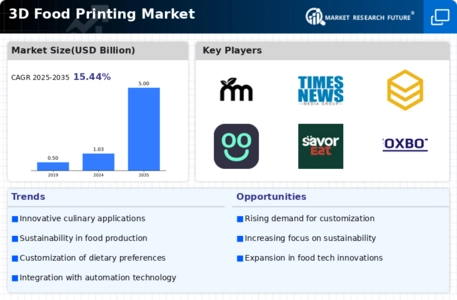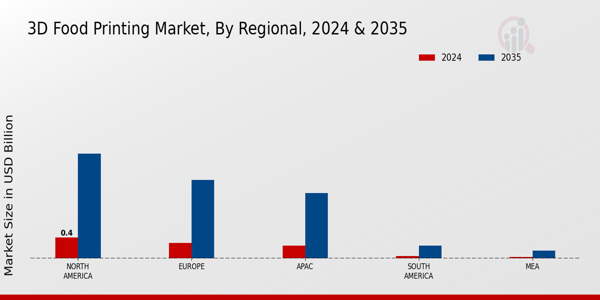Market Growth Charts
Sustainability Initiatives
Sustainability initiatives are becoming increasingly relevant within the Global 3D Food Printing Market Industry. As consumers become more environmentally conscious, the demand for sustainable food production methods is rising. 3D food printing offers the potential to reduce food waste by utilizing ingredients more efficiently and creating products on demand. Moreover, the ability to incorporate alternative proteins and plant-based materials aligns with global sustainability goals. This shift towards eco-friendly practices is expected to resonate with consumers, thereby driving market growth. The industry's commitment to sustainability may play a crucial role in achieving a compound annual growth rate of 15.45% from 2025 to 2035.
Technological Advancements
The Global 3D Food Printing Market Industry is experiencing rapid technological advancements, which are enhancing the capabilities of food printers. Innovations in materials, such as plant-based and protein-rich ingredients, are expanding the range of printable foods. For instance, the development of new food-grade inks allows for more intricate designs and textures, appealing to both consumers and chefs. As these technologies evolve, they are expected to drive market growth, with the industry projected to reach 1.03 USD Billion in 2024. This trend suggests a growing acceptance of 3D printed food in culinary applications, potentially reshaping dining experiences globally.
Health and Nutrition Trends
Health and nutrition trends are significantly influencing the Global 3D Food Printing Market Industry. With an increasing focus on health-conscious eating, consumers are seeking foods that are not only delicious but also nutritious. 3D food printing technology allows for the precise formulation of food items, enabling manufacturers to create products that meet specific dietary needs, such as low-calorie or high-protein options. This capability is particularly appealing to fitness enthusiasts and individuals with dietary restrictions. As health trends continue to shape consumer preferences, the market is poised for growth, with the potential to reach 1.03 USD Billion in 2024.
Market Expansion Opportunities
The Global 3D Food Printing Market Industry is witnessing numerous market expansion opportunities, particularly in emerging economies. As urbanization increases and disposable incomes rise, there is a growing appetite for innovative food solutions. Countries in Asia-Pacific and Latin America are beginning to adopt 3D food printing technologies, driven by a youthful population eager for novel culinary experiences. This expansion is likely to be supported by local startups and established food companies exploring 3D printing as a means to differentiate their offerings. The anticipated growth in these regions could contribute to the overall market, with projections indicating a substantial increase by 2035.
Customization and Personalization
Customization and personalization are emerging as pivotal drivers in the Global 3D Food Printing Market Industry. Consumers increasingly seek unique food experiences tailored to their preferences, dietary restrictions, and aesthetic desires. 3D food printing enables chefs and food manufacturers to create bespoke dishes that cater to individual tastes, enhancing customer satisfaction. This trend is particularly evident in high-end restaurants and specialty food shops, where personalized food items are gaining popularity. As the market evolves, the demand for customized food solutions is likely to contribute to the industry's growth, with projections indicating a market size of 5 USD Billion by 2035.












Leave a Comment